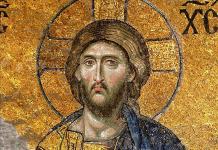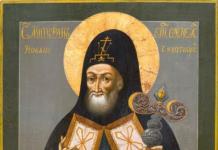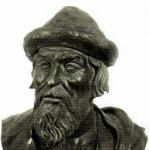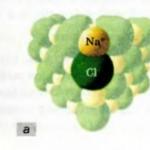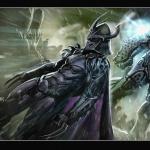Michael Faraday(English) Michael Faraday, 22 September 1791, London - 25 August 1867, London) - English experimental physicist and chemist. Member of London
Royal Society (1824) and many other scientific organizations, including a foreign honorary member of the St. Petersburg Academy of Sciences (1830).
Discovered electromagnetic induction, which underlies modern industrial electricity production and many of its applications. Created the first model of an electric motor. Among his other discoveries are the first transformer, the chemical effect of current, the laws of electrolysis, the effect of a magnetic field on light, and diamagnetism. He was the first to predict electromagnetic waves. Faraday introduced into scientific use the terms ion, cathode, anode, electrolyte, dielectric, diamagnetism, paramagnetism, etc.
Faraday is the founder of the doctrine of the electromagnetic field, which was then mathematically formulated and developed by Maxwell. Faraday's main ideological contribution to the physics of electromagnetic phenomena was the rejection of Newton's principle of long-range action and the introduction of the concept of a physical field - a continuous region of space, completely filled with lines of force and interacting with matter.


Lorentz is best known for his work in the fields of electrodynamics and optics. Combining the concept of a continuous electromagnetic field with the idea of discrete electric charges that make up matter, he created the classical electronic theory and applied it to solve many particular problems: he obtained an expression for the force acting on a moving charge from the electromagnetic field (Lorentz force), and derived formula connecting the refractive index of a substance with its density (Lorentz-Lorentz formula), developed the theory of light dispersion, explained a number of magneto-optical phenomena (in particular, the Zeeman effect) and some properties of metals. Based on electronic theory, the scientist developed the electrodynamics of moving media, including putting forward a hypothesis about the contraction of bodies in the direction of their movement (Fitzgerald - Lorentz contraction), introduced the concept of “local time”, obtained a relativistic expression for the dependence of mass on speed, and derived relationships between coordinates and time in inertial reference systems moving relative to each other (Lorentz transformations). Lorentz's work contributed to the formation and development of the ideas of the special theory of relativity and quantum physics. In addition, he obtained a number of significant results in the thermodynamics and kinetic theory of gases, the general theory of relativity, and the theory of thermal radiation.

He also predicted "quantum teleportation" and predicted and measured the Einstein-de Haas gyromagnetic effect. Since 1933, he worked on problems of cosmology and unified field theory. He actively opposed war, against the use of nuclear weapons, for humanism, respect for human rights, and mutual understanding between peoples.
Einstein played a decisive role in popularizing and introducing new physical concepts and theories into scientific circulation. First of all, this relates to a revision of the understanding of the physical essence of space and time and to the construction of a new theory of gravity to replace the Newtonian one. Einstein also, together with Planck, laid the foundations of quantum theory. These concepts, repeatedly confirmed by experiments, form the foundation of modern physics.
Plan:
- Introduction
- 1 Basic Concepts
- 2 Basic Equations
- 3 Contents of electrodynamics
- 4 Sections of electrodynamics
- 5 Application value
- 6 History
Introduction
Electrodynamics- a branch of physics that studies the electromagnetic field in the most general case (that is, time-dependent variable fields are considered) and its interaction with bodies that have an electric charge (electromagnetic interaction). The subject of electrodynamics includes the connection between electrical and magnetic phenomena, electromagnetic radiation (in different conditions, both free and in various cases of interaction with matter), electric current (generally speaking, variable) and its interaction with the electromagnetic field (electric current can be considered when this is like a collection of moving charged particles). Any electrical and magnetic interaction between charged bodies is considered in modern physics as occurring through an electromagnetic field, and, therefore, is also the subject of electrodynamics.
Most often under the term electrodynamics by default, classical (not affecting quantum effects) electrodynamics is understood; To denote the modern quantum theory of the electromagnetic field and its interaction with charged particles, the stable term quantum electrodynamics is usually used.
1. Basic concepts
The basic concepts used in electrodynamics include:
- The electromagnetic field is the main subject of study of electrodynamics, a type of matter that manifests itself when interacting with charged bodies. Historically divided into two fields:
- Electric field - created by any charged body or alternating magnetic field, has an effect on any charged body.
- Magnetic field - created by moving charged bodies, charged bodies with spin, and alternating electric fields, affects moving charges and charged bodies with spin.
- Electric charge is a property of bodies that allows them to create electromagnetic fields, as well as interact with these fields.
- Electromagnetic potential is a 4-vector physical quantity that completely determines the distribution of the electromagnetic field in space. Highlight:
- Electrostatic potential - time component of a 4-vector
- Vector potential is a three-dimensional vector formed by the remaining components of a 4-vector.
- The Poynting vector is a vector physical quantity that has the meaning of the energy flux density of an electromagnetic field.
2. Basic equations
The basic equations describing the behavior of the electromagnetic field and its interaction with charged bodies are:
- Maxwell's equations, which determine the behavior of a free electromagnetic field in a vacuum and a medium, as well as the generation of the field by sources. Among these equations are:
- Faraday's law of induction, which determines the generation of an electric field by an alternating magnetic field.
- The magnetic field circulation theorem with the addition of displacement currents introduced by Maxwell determines the generation of a magnetic field by moving charges and an alternating electric field
- Gauss's theorem for the electric field, which determines the generation of an electrostatic field by charges.
- The law of closure of magnetic field lines.
- An expression for the Lorentz force that determines the force acting on a charge located in an electromagnetic field.
- The Joule-Lenz law, which determines the amount of heat loss in a conducting medium with finite conductivity, in the presence of an electric field in it.
Particular equations of particular importance are:
- Coulomb's law, which combines Gauss' theorem for the electric field and the Lorentz force, and determines the electrostatic interaction of two point charges.
- Ampere's law, which determines the force acting on an elementary current placed in a magnetic field.
- Poynting's theorem, which expresses the law of conservation of energy in electrodynamics.
3. Contents of electrodynamics
The main content of classical electrodynamics is the description of the properties of the electromagnetic field and its interaction with charged bodies (charged bodies “generate” the electromagnetic field, are its “sources,” and the electromagnetic field in turn acts on charged bodies, creating electromagnetic forces). This description, in addition to defining basic objects and quantities, such as electric charge, electric field, magnetic field, electromagnetic potential, is reduced to Maxwell’s equations in one form or another and the Lorentz force formula, and also touches on some related issues (related to mathematical physics, applications, auxiliary quantities and auxiliary formulas important for applications, such as the current density vector or empirical Ohm's law). This description also includes issues of conservation and transfer of energy, momentum, angular momentum by an electromagnetic field, including formulas for energy density, Poynting vector, etc.
Sometimes, electrodynamic effects (as opposed to electrostatics) are understood as those significant differences between the general case of the behavior of the electromagnetic field (for example, the dynamic relationship between changing electric and magnetic fields) from the static case, which make the particular static case much simpler to describe, understand and calculate.
4. Sections of electrodynamics
- Electrostatics describes the properties of a static (not changing with time or changing slowly enough that “electrodynamic effects” in the sense described above can be neglected) electric field and its interaction with electrically charged bodies (electric charges).
- Magnetostatics studies direct currents and constant magnetic fields (the fields do not change over time or change so slowly that the speed of these changes can be neglected in the calculation), as well as their interaction.
- Continuum electrodynamics examines the behavior of electromagnetic fields in continuous media.
- Relativistic electrodynamics considers electromagnetic fields in moving media.
5. Application value
Electrodynamics underlies physical optics, the physics of radio wave propagation, and also permeates almost all physics, since almost all branches of physics have to deal with electric fields and charges, and often with their non-trivial rapid changes and movements. In addition, electrodynamics is an exemplary physical theory (both in its classical and quantum versions), combining very high accuracy of calculations and predictions with the influence of theoretical ideas born in its field on other areas of theoretical physics.
Electrodynamics is of great importance in technology and forms the basis of: radio engineering, electrical engineering, various branches of communications and radio.
6. History
The first proof of the connection between electrical and magnetic phenomena was Oersted's experimental discovery in 1819-1820 of the generation of a magnetic field by electric current. He also expressed the idea of some interaction of electrical and magnetic processes in the space surrounding the conductor, but in a rather unclear form.
In 1831, Michael Faraday experimentally discovered the phenomenon and law of electromagnetic induction, which became the first clear evidence of the direct dynamic relationship of electric and magnetic fields. He also developed (in relation to electric and magnetic fields) the fundamentals of the concept of a physical field and some basic theoretical concepts that make it possible to describe physical fields, and also predicted the existence of electromagnetic waves in 1832.
In 1864, J. C. Maxwell first published the complete system of equations of "classical electrodynamics" describing the evolution of the electromagnetic field and its interaction with charges and currents. He made a theoretically based assumption that light is an electromagnetic wave, i.e. object of electrodynamics.
FUNDAMENTALS OF ELECTRODYNAMICS. ELECTROSTATICS
FUNDAMENTALS OF ELECTRODYNAMICS
Electrodynamics- the science of the properties of the electromagnetic field.
Electromagnetic field- determined by the movement and interaction of charged particles.
Manifestation of electric/magnetic field- this is the action of electric/magnetic forces:
1) frictional forces and elastic forces in the macrocosm;
2) the action of electric/magnetic forces in the microcosm (atomic structure, coupling of atoms into molecules,
transformation of elementary particles)
Discovery of the electric/magnetic field- J. Maxwell.
ELECTROSTATICS
The branch of electrodynamics studies electrically charged bodies at rest.
Elementary particles may have email charge, then they are called charged;
- interact with each other with forces that depend on the distance between particles,
but exceed many times the forces of mutual gravity (this interaction is called
electromagnetic).
Email charge- physical value determines the intensity of electric/magnetic interactions.
There are 2 signs of electric charges: positive and negative.
Particles with like charges repel, and particles with unlike charges attract.
A proton has a positive charge, an electron has a negative charge, and a neutron is electrically neutral.
Elementary charge- a minimum charge that cannot be divided.
How can we explain the presence of electromagnetic forces in nature?
- All bodies contain charged particles.
In the normal state of the body, el. neutral (since the atom is neutral), and electric/magnetic. powers are not manifested.
Body is charged, if it has an excess of charges of any sign:
negatively charged - if there is an excess of electrons;
positively charged - if there is a lack of electrons.
Electrification of bodies- this is one of the ways to obtain charged bodies, for example, by contact).
In this case, both bodies are charged, and the charges are opposite in sign, but equal in magnitude.
Law of conservation of electric charge.
In a closed system, the algebraic sum of the charges of all particles remains unchanged.
(... but not the number of charged particles, since there are transformations of elementary particles).
Closed system
A system of particles into which charged particles do not enter from the outside and do not exit.
Coulomb's law
Basic law of electrostatics.

The force of interaction between two point stationary charged bodies in a vacuum is directly proportional
the product of the charge modules and is inversely proportional to the square of the distance between them.
When bodies are considered point bodies? - if the distance between them is many times greater than the size of the bodies.
If two bodies have electric charges, then they interact according to Coulomb's law.
Unit of electric charge
1 C is a charge passing through the cross-section of a conductor in 1 second at a current of 1 A.
1 C is a very large charge.
Elemental charge:
ELECTRIC FIELD
There is an electrical charge around, materially.
The main property of the electric field: the action with force on the electric charge introduced into it.
Electrostatic field- the field of a stationary electric charge does not change with time.
Electric field strength.- quantitative characteristics of el. fields.
is the ratio of the force with which the field acts on the introduced point charge to the magnitude of this charge.
- does not depend on the magnitude of the introduced charge, but characterizes the electric field!
Tension vector direction
coincides with the direction of the force vector acting on a positive charge, and opposite to the direction of the force acting on a negative charge.
Point charge field strength:

where q0 is the charge creating the electric field.
At any point in the field, the intensity is always directed along the straight line connecting this point and q0.

ELECTRIC CAPACITY
Characterizes the ability of two conductors to accumulate electrical charge.
- does not depend on q and U.
- depends on the geometric dimensions of the conductors, their shape, relative position, electrical properties of the medium between the conductors.


SI units: (F - farad)

CAPACITORS
Electrical device that stores charge
(two conductors separated by a dielectric layer).

Where d is much smaller than the dimensions of the conductor.
Designation on electrical diagrams:
![]()
The entire electric field is concentrated inside the capacitor.
The charge of a capacitor is the absolute value of the charge on one of the capacitor plates.
Types of capacitors:
1. by type of dielectric: air, mica, ceramic, electrolytic
2. according to the shape of the plates: flat, spherical.
3. by capacity: constant, variable (adjustable).
Electrical capacitance of a flat capacitor

where S is the area of the plate (plating) of the capacitor
d - distance between plates
eo - electrical constant
e - dielectric constant of the dielectric
Including capacitors in an electrical circuit
parallel

sequential

Then the total electrical capacity (C):
when connected in parallel
. 
when connected in series

DC AC CONNECTIONS
Electricity- ordered movement of charged particles (free electrons or ions).
In this case, electricity is transferred through the cross section of the conductor. charge (during the thermal movement of charged particles, the total transferred electrical charge = 0, since positive and negative charges are compensated).

Email direction current- it is conventionally accepted to consider the direction of movement of positively charged particles (from + to -).
Email actions current (in conductor):
thermal effect of current- heating of the conductor (except for superconductors);
chemical effect of current - appears only in electrolytes. Substances that make up the electrolyte are released on the electrodes;
magnetic effect of current(main) - observed in all conductors (deflection of the magnetic needle near a conductor with current and the force effect of the current on neighboring conductors through a magnetic field).
OHM'S LAW FOR A CIRCUIT SECTION

where , R is the resistance of the circuit section. (the conductor itself can also be considered a section of the circuit).
Each conductor has its own specific current-voltage characteristic.

RESISTANCE
Basic electrical characteristics of a conductor.
- according to Ohm's law, this value is constant for a given conductor.

1 Ohm is the resistance of a conductor with a potential difference at its ends
at 1 V and the current strength in it is 1 A.
Resistance depends only on the properties of the conductor:

where S is the cross-sectional area of the conductor, l is the length of the conductor,
ro - resistivity characterizing the properties of the conductor substance.
![]()
ELECTRICAL CIRCUITS
They consist of a source, a consumer of electric current, wires, and a switch.
SERIES CONNECTION OF CONDUCTORS

I - current strength in the circuit
U - voltage at the ends of the circuit section
PARALLEL CONNECTION OF CONDUCTORS

I - current strength in an unbranched section of the circuit
U - voltage at the ends of the circuit section
R - total resistance of the circuit section
Remember how measuring instruments are connected:

Ammeter - connected in series with the conductor in which the current is measured.

Voltmeter - connected in parallel to the conductor on which the voltage is measured.
DC OPERATION
Current work- this is the work of the electric field to transfer electric charges along the conductor;
The work done by the current on a section of the circuit is equal to the product of the current, voltage and time during which the work was performed.
Using the formula of Ohm's law for a section of a circuit, you can write several versions of the formula for calculating the work of the current:

According to the law of conservation of energy:
The work is equal to the change in the energy of a section of the circuit, so the energy released by the conductor is equal to the work of the current.
In the SI system:

JOULE-LENZ LAW
When current passes through a conductor, the conductor heats up and heat exchange occurs with the environment, i.e. the conductor gives off heat to the bodies surrounding it.
The amount of heat released by a conductor carrying current into the environment is equal to the product of the square of the current strength, the resistance of the conductor and the time the current passes through the conductor.

According to the law of conservation of energy, the amount of heat released by a conductor is numerically equal to the work done by the current flowing through the conductor during the same time.
In the SI system:
[Q] = 1 J
DC POWER
The ratio of the work done by the current during time t to this time interval.

In the SI system:
![]()
The phenomenon of superconductivity
Discovery of low temperature superconductivity:
1911 - Dutch scientist Kamerling - Onnes
observed at ultra-low temperatures (below 25 K) in many metals and alloys;
At such temperatures, the resistivity of these substances becomes vanishingly small.
In 1957, a theoretical explanation of the phenomenon of superconductivity was given:
Cooper (USA), Bogolyubov (USSR)
1957 Collins's experiment: the current in a closed circuit without a current source did not stop for 2.5 years.
In 1986, high-temperature superconductivity (at 100 K) was discovered (for metal-ceramics).

Difficulty of achieving superconductivity:
- the need for strong cooling of the substance
Application area:
- obtaining strong magnetic fields;
- powerful electromagnets with superconducting winding in accelerators and generators.
Currently in the energy sector there is a big problem
- large losses of electricity during transmission her by wire.
Possible Solution Problems:
with superconductivity, the resistance of the conductors is approximately 0
and energy losses are sharply reduced.
Substance with the highest superconducting temperature
In 1988 in the USA, at a temperature of –148°C, the phenomenon of superconductivity was obtained. The conductor was a mixture of thallium, calcium, barium and copper oxides - Tl2Ca2Ba2Cu3Ox.
Semiconductor -
A substance whose resistivity can vary over a wide range and decreases very quickly with increasing temperature, which means that the electrical conductivity (1/R) increases.
- observed in silicon, germanium, selenium and some compounds.
Conduction mechanism in semiconductors
Semiconductor crystals have an atomic crystal lattice where outer electrons are bonded to neighboring atoms by covalent bonds.
At low temperatures, pure semiconductors have no free electrons and behave like an insulator.

ELECTRIC CURRENT IN VACUUM
What is a vacuum?
- this is the degree of rarefaction of a gas at which there are practically no collisions of molecules;

Electric current is not possible because the possible number of ionized molecules cannot provide electrical conductivity;
- it is possible to create electric current in a vacuum if you use a source of charged particles;
- the action of a source of charged particles can be based on the phenomenon of thermionic emission.
Thermionic emission
- this is the emission of electrons by solid or liquid bodies when they are heated to temperatures corresponding to the visible glow of hot metal.
The heated metal electrode continuously emits electrons, forming an electron cloud around itself.
In an equilibrium state, the number of electrons that left the electrode is equal to the number of electrons that returned to it (since the electrode becomes positively charged when electrons are lost).
The higher the temperature of the metal, the higher the density of the electron cloud.
Vacuum diode
Electric current in a vacuum is possible in vacuum tubes.
A vacuum tube is a device that uses the phenomenon of thermionic emission.

A vacuum diode is a two-electrode (A - anode and K - cathode) electron tube.
Very low pressure is created inside the glass container
![]()
H - filament placed inside the cathode to heat it. The surface of the heated cathode emits electrons. If the anode is connected to + of the current source, and the cathode is connected to -, then the circuit flows
constant thermionic current. The vacuum diode has one-way conductivity.
Those. current in the anode is possible if the anode potential is higher than the cathode potential. In this case, electrons from the electron cloud are attracted to the anode, creating an electric current in a vacuum.
Current-voltage characteristic of a vacuum diode.

At low anode voltages, not all the electrons emitted by the cathode reach the anode, and the electric current is small. At high voltages, the current reaches saturation, i.e. maximum value.
A vacuum diode is used to rectify alternating current.
Current at the input of the diode rectifier:

Rectifier output current:

Electron beams
This is a stream of rapidly flying electrons in vacuum tubes and gas-discharge devices.
Properties of electron beams:
Deflects in electric fields;
- deflect in magnetic fields under the influence of the Lorentz force;
- when a beam hitting a substance is decelerated, X-ray radiation appears;
- causes glow (luminescence) of some solids and liquids (luminophores);
- heat the substance by contacting it.
Cathode ray tube (CRT)
Thermionic emission phenomena and properties of electron beams are used.

A CRT consists of an electron gun, horizontal and vertical deflectors
electrode plates and screen.
In an electron gun, electrons emitted by a heated cathode pass through the control grid electrode and are accelerated by the anodes. An electron gun focuses an electron beam into a point and changes the brightness of the light on the screen. Deflecting horizontal and vertical plates allow you to move the electron beam on the screen to any point on the screen. The tube screen is coated with a phosphor that begins to glow when bombarded with electrons.
There are two types of tubes:
1) with electrostatic control of the electron beam (deflection of the electric beam only by the electric field);
2) with electromagnetic control (magnetic deflection coils are added).
Main applications of CRT:
picture tubes in television equipment;
computer displays;
electronic oscilloscopes in measuring technology.
ELECTRIC CURRENT IN GASES
Under normal conditions, gas is a dielectric, i.e. it consists of neutral atoms and molecules and does not contain free carriers of electric current.
The conductor gas is an ionized gas. Ionized gas has electron-ion conductivity.
Air is a dielectric in power lines, air capacitors, and contact switches.
Air is a conductor when lightning, an electric spark occurs, or when a welding arc occurs.
Gas ionization

It is the breakdown of neutral atoms or molecules into positive ions and electrons by removing electrons from the atoms. Ionization occurs when a gas is heated or exposed to radiation (UV, X-rays, radioactive) and is explained by the disintegration of atoms and molecules during collisions at high speeds.
Gas discharge
This is electric current in ionized gases.
The charge carriers are positive ions and electrons. Gas discharge is observed in gas-discharge tubes (lamps) when exposed to an electric or magnetic field.


Recombination of charged particles

- the gas ceases to be a conductor if ionization stops, this occurs as a result of recombination (reunion of oppositely charged particles).
There is a self-sustaining and non-self-sustaining gas discharge.
Non-self-sustaining gas discharge
If the action of the ionizer is stopped, the discharge will also stop.
When the discharge reaches saturation, the graph becomes horizontal. Here, the electrical conductivity of the gas is caused only by the action of the ionizer.
Self-sustaining gas discharge
In this case, the gas discharge continues even after the termination of the external ionizer due to ions and electrons resulting from impact ionization (= ionization of electric shock); occurs when the potential difference between the electrodes increases (an electron avalanche occurs).
A non-self-sustained gas discharge can transform into a self-sustained gas discharge when Ua = Uignition.
Electrical breakdown of gas
The process of transition of a non-self-sustaining gas discharge into a self-sustaining one.
Self-sustained gas discharge occurs 4 types:
1. smoldering - at low pressures (up to several mm Hg) - observed in gas-light tubes and gas lasers.
2. spark - at normal pressure and high electric field strength (lightning - current strength up to hundreds of thousands of amperes).
3. corona - at normal pressure in a non-uniform electric field (at the tip).
4. arc - high current density, low voltage between the electrodes (gas temperature in the arc channel -5000-6000 degrees Celsius); observed in spotlights and projection film equipment.
These discharges are observed:
smoldering - in fluorescent lamps;
spark - in lightning;
corona - in electric precipitators, during energy leakage;
arc - during welding, in mercury lamps.
Plasma
This is the fourth state of aggregation of a substance with a high degree of ionization due to the collision of molecules at high speed at high temperature; found in nature: ionosphere - weakly ionized plasma, Sun - fully ionized plasma; artificial plasma - in gas-discharge lamps.
Plasma can be:
Low temperature - at temperatures less than 100,000K;
high temperature - at temperatures above 100,000K.
Basic properties of plasma:
High electrical conductivity
- strong interaction with external electric and magnetic fields.
At a temperature ![]()
Any substance is in a plasma state.
Interestingly, 99% of the matter in the Universe is plasma
TEST QUESTIONS FOR TESTING
Definition 1
Electrodynamics is a huge and important field of physics that studies the classical, non-quantum properties of the electromagnetic field and the motion of positively charged magnetic charges interacting with each other using this field.
Figure 1. Briefly about electrodynamics. Author24 - online exchange of student works
Electrodynamics seems to be a wide range of different formulations of problems and their intelligent solutions, approximate methods and special cases, which are combined into one whole by general initial laws and equations. The latter, making up the main part of classical electrodynamics, are presented in detail in Maxwell's formulas. Currently, scientists continue to study the principles of this area in physics, the skeleton of its construction, relationships with other scientific areas.
Coulomb's law in electrodynamics is denoted as follows: $F= \frac (kq1q2) (r2)$, where $k= \frac (9 \cdot 10 (H \cdot m)) (Kl)$. The electric field strength equation is written as follows: $E= \frac (F)(q)$, and the flux of the magnetic field induction vector $∆Ф=В∆S \cos (a)$.
In electrodynamics, free charges and systems of charges, which contribute to the activation of a continuous energy spectrum, are primarily studied. The classical description of electromagnetic interaction is favored by the fact that it is effective already in the low-energy limit, when the energy potential of particles and photons is small compared to the rest energy of the electron.
In such situations, there is often no annihilation of charged particles, since there is only a gradual change in the state of their unstable motion as a result of the exchange of a large number of low-energy photons.
Note 1
However, even at high energies of particles in the medium, despite the significant role of fluctuations, electrodynamics can be successfully used for a comprehensive description of statistically average, macroscopic characteristics and processes.
Basic equations of electrodynamics
The main formulas that describe the behavior of the electromagnetic field and its direct interaction with charged bodies are Maxwell’s equations, which determine the probable actions of a free electromagnetic field in a medium and vacuum, as well as the general generation of the field by sources.
Among these provisions in physics it is possible to highlight:
- Gauss's theorem for the electric field - intended to determine the generation of an electrostatic field by positive charges;
- hypothesis of closed field lines - promotes the interaction of processes within the magnetic field itself;
- Faraday's law of induction - establishes the generation of electric and magnetic fields by the variable properties of the environment.
In general, the Ampere-Maxwell theorem is a unique idea about the circulation of lines in a magnetic field with the gradual addition of displacement currents introduced by Maxwell himself, which precisely determines the transformation of the magnetic field by moving charges and the alternating action of the electric field.
Charge and force in electrodynamics
In electrodynamics, the interaction of force and charge of the electromagnetic field comes from the following joint definition of the electric charge $q$, energy $E$ and magnetic $B$ fields, which are established as a fundamental physical law based on the entire set of experimental data. The formula for the Lorentz force (within the idealization of a point charge moving at a certain speed) is written with the replacement of the speed $v$.
Conductors often contain a huge amount of charges, therefore, these charges are fairly well compensated: the number of positive and negative charges is always equal to each other. Consequently, the total electric force that constantly acts on the conductor is also zero. The magnetic forces operating on individual charges in a conductor are ultimately not compensated, because in the presence of current, the speeds of movement of the charges are always different. The equation for the action of a conductor with current in a magnetic field can be written as follows: $G = |v ⃗ |s \cos(a) $
If we study not a liquid, but a full and stable flow of charged particles as a current, then the entire energy potential passing linearly through the area for $1s$ will be the current strength equal to: $I = ρ| \vec (v) |s \cos(a) $, where $ρ$ is the charge density (per unit volume in the total flow).
Note 2
If the magnetic and electric field systematically changes from point to point on a specific site, then in the expressions and formulas for partial flows, as in the case of liquid, the average values $E ⃗ $ and $B ⃗$ on the site must be entered.
The special position of electrodynamics in physics
The significant position of electrodynamics in modern science can be confirmed through the famous work of A. Einstein, in which the principles and foundations of the special theory of relativity were outlined in detail. The scientific work of the outstanding scientist is called “On the electrodynamics of moving bodies,” and includes a huge number of important equations and definitions.
As a separate field of physics, electrodynamics consists of the following sections:
- the doctrine of the field of stationary but electrically charged physical bodies and particles;
- the doctrine of the properties of electric current;
- the doctrine of the interaction of magnetic field and electromagnetic induction;
- the study of electromagnetic waves and oscillations.
All of the above sections are united into one by the theorem of D. Maxwell, who not only created and presented a coherent theory of the electromagnetic field, but also described all its properties, proving its real existence. The work of this particular scientist showed the scientific world that the electric and magnetic fields known at that time are just a manifestation of a single electromagnetic field operating in different reference systems.
A significant part of physics is devoted to the study of electrodynamics and electromagnetic phenomena. This area largely lays claim to the status of a separate science, since it not only explores all the patterns of electromagnetic interactions, but also describes them in detail through mathematical formulas. Deep and long-term research in electrodynamics has opened new ways for the use of electromagnetic phenomena in practice, for the benefit of all mankind.
Definition 1
Electrodynamics is a branch of physics that studies the basic variables of the electromagnetic field and their interaction.
Classical electrodynamics describes all the properties of the electromagnetic field and the principles of its relationship with other physical elements that carry a certain electric charge. This action can be determined through Maxwell's equations, and the Lorentz power expression. In this case, the following main concepts of electrodynamics are always used: electromagnetic field, electromagnetic potential, electric charge and Poynting vector.
The main sections of this direction in physics include:
- magnetostatics;
- electrostatics;
- electrodynamics of a continuous medium.
The basis for optics, as a branch of science, is electrodynamics in the form of the physics of radio waves. This scientific direction is considered the foundation for electrical and radio engineering.
Electric charge
Electromagnetic interactions are among the most important activities in nature. The forces of elasticity and friction, the pressure of gas and liquid can be reduced to a single indicator of the electromagnetic force between the elements of matter. The interactions themselves in electrodynamics can no longer form in deeper forms of interactions.
Note 1
The same fundamental type of complementarity is gravitation - the gravitational and constant attraction of two physical bodies.
However, several important differences can be observed between gravitational processes and electromagnetic ones:
- Only charged bodies can take part in electromagnetic interactions;
- gravitational connection is always the systematic attraction of one body to another;
- electromagnetic relationships can be either repulsion or attraction;
- interaction in electrodynamics is much more intense than gravitational interaction;
- Every charged body has a certain amount of electric charge.
Definition 2
Electric charge is a specific physical quantity that more accurately determines the strength of electromagnetic interaction between nature and objects, the unit of measurement of which is the coulomb (C)1.
Electric field
The theory of short-range interaction prevailed over the previously proposed hypotheses of scientists, as a result of which the electromagnetic field turned out to be the main object that fully conveys the interaction between charges even through a vacuum. Decisive in this area were the works and works of two famous scientists of the 19th century - Faraday and Maxwell. Physicists were able to discover the principle of operation of the electric field through experimental confirmation of their statements.
Fixed charges cannot form a magnetic field, therefore, in this aspect it is necessary to talk only about the properties of the electric field itself.
So, the main characteristics of the field in electrodynamics are:
- an electric charge can create a powerful field around itself;
- electrodynamics does not require any specific medium and can arise in matter and in vacuum; it is a good alternative form of existence for all matter;
- The electric field is a primary physical object that establishes the laws of behavior of the dynamics of processes in an electrical circuit.
The sources of the electric field are considered to be constant electric charges, and the indicator for studying this phenomenon is the so-called test charge. By the action of this substance one can judge the presence of an electric field in a certain space. In addition, by means of a test charge, it is possible to determine the field strength in various spheres of its interaction. Naturally, this element in electrodynamics must be point and constant.
According to scientists, the force that influences the test charge in an electric field is absolutely proportional to the magnitude of the total charge. Therefore, the ratio of intensity to energy flow no longer depends on the charge index and is one of the properties of the field.
The electric field strength is the relationship between the force vector $\vec (F)$, with which the electromagnetic field acts on the test charge $q$, and the test charge itself: $((\vec (E))=(\frac (\vec ( F))(q)).)$
The voltage of substances in the field is considered a vector quantity, where at each point in space there is a certain coefficient of the test element. A field is given if it is possible to determine the dependence of the specified intensity vector on the given coordinates of the point and on time.
Note 2
As follows from this definition, tension is usually measured in N/kl, but today it is only possible to study the properties of this process.
Conductors in an electric field
Electric current can be easily obtained if the poles of the battery are short-circuited with a metal wire, but if the wire is replaced with an ordinary glass rod, no current will arise. Metal is the main conductor, and glass acts as a dielectric.
Conductors in electrodynamics differ from dielectrics in the absence of extra charges, charged elements, the position of which is in no way related to a point inside the substance itself. Free charges begin to actively interact under the influence of an electric field and can move throughout the entire volume of the conductor.
Definition 3
Conductors are primarily metals in which only free electrons are considered absolutely free charges, which arise from the peculiarities of the metallic bonding process.
The fact is that the permanent valence electron, which is located on the outer electron shell of the metal atom, is rather weakly bound to the atomic nucleus. When metal atoms are interconnected, their valence particles remain without a shell and “set off to float freely.”
Electrolytes, which are solutions and melts, free nano-charges, in which the dissociation of molecules into positive and negative ions is manifested, also act as conductors in an electric field. If you throw a pinch of table salt into a glass of ordinary water, then the $NaCl$ molecules gradually break down into positive ions $Na^+$ and $Cl^−$. Under the influence of an electric field, these indicators will begin to form an ordered movement, resulting in an electric current.
Natural water is a good conductor due to the presence of salts dissolved in it, but not as good as metals. Everyone knows that the human body mainly consists of water, in which certain salt elements are also dissolved. Therefore, our body also acts as a conductor of electric current.
It is worth noting that due to the presence of a huge number of free charges that are able to move throughout the entire spatial volume, conductors have some characteristic common properties.
Electromechanical analogy
It is easy to notice a certain analogy between the inductance $L$ in electrodynamics and the mass $m$ in mechanics. It is known that in order to fully accelerate a body to a certain speed, it is necessary to spend some time, since it is impossible to instantly change the speed of a physical body.
At a constant intensity applied to the body, this time will directly depend on the mass $m$ of the body. In order for the current in the coil to reach its maximum value, time is required to establish the inductance $L$ of the coil.
The speed of the body will automatically decrease if substances in the electric field collide with a stationary wall. The wall takes the entire blow, and its destructive power is stronger, the greater the mass of the body itself. In fact, all electromechanical analogies extend quite far and relate not only to inductance and mass, but also to other indicators that are not extremely useful in practice.
The realization of the unity and constancy of the electrical and magnetic relationship became the first confirmed example of the theory of unification of physical interactions. Today it has been proven that electrodynamics and weak interactions at high energies are combined in a single process.
